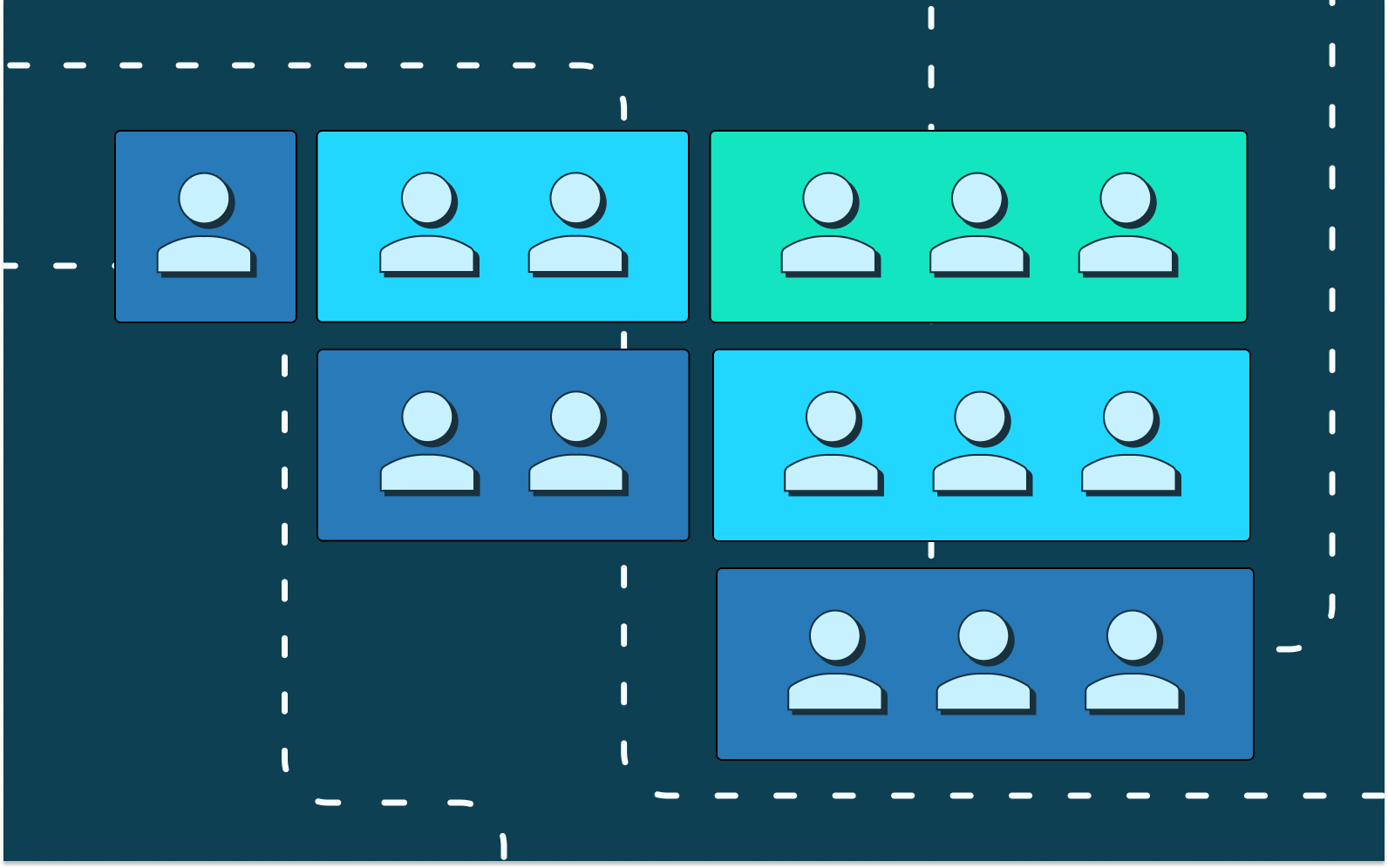Back to blog
Stytch Talks with Enzo Avigo: Building a high-performing B2B sign up flow
Company
May 2, 2023
Author: Stytch Team

How do onboarding processes impact the B2B user experience? And how can B2B app developers build sign up and log in flows that maximize conversion and retention rates?
These are common questions in the authentication community, and they were top of mind when Stytch’s Reed McGinley-Stempel invited Enzo Avigo to join our Stytch Talks webinar series. As the co-founder and CEO of June, a plug-and-play product analytics tool for B2B SaaS, Enzo sees first-hand the effects that frictionless onboarding flows can have on user engagement — and his professional background in product management has instilled a passion for simple SaaS solutions that are easy to use right off the bat.
Missed the live webinar and Q&A? You can access a full recording of the event over on our YouTube channel.
Optimizing your B2B onboarding can be a complicated lift, as there are unique considerations when it comes to managing organizations, preventing account deduplication, and implementing complex auth flows like single sign on (SSO) and multi-factor authentication (MFA), among other things. But there are certain steps you can take and best practices you can follow to ensure it’s worth your while.
In this post, we recap the expert tips Reed and Enzo had to share from their respective domains of auth and analytics — so you can build smooth, secure B2B sign up flows that convert and delight.
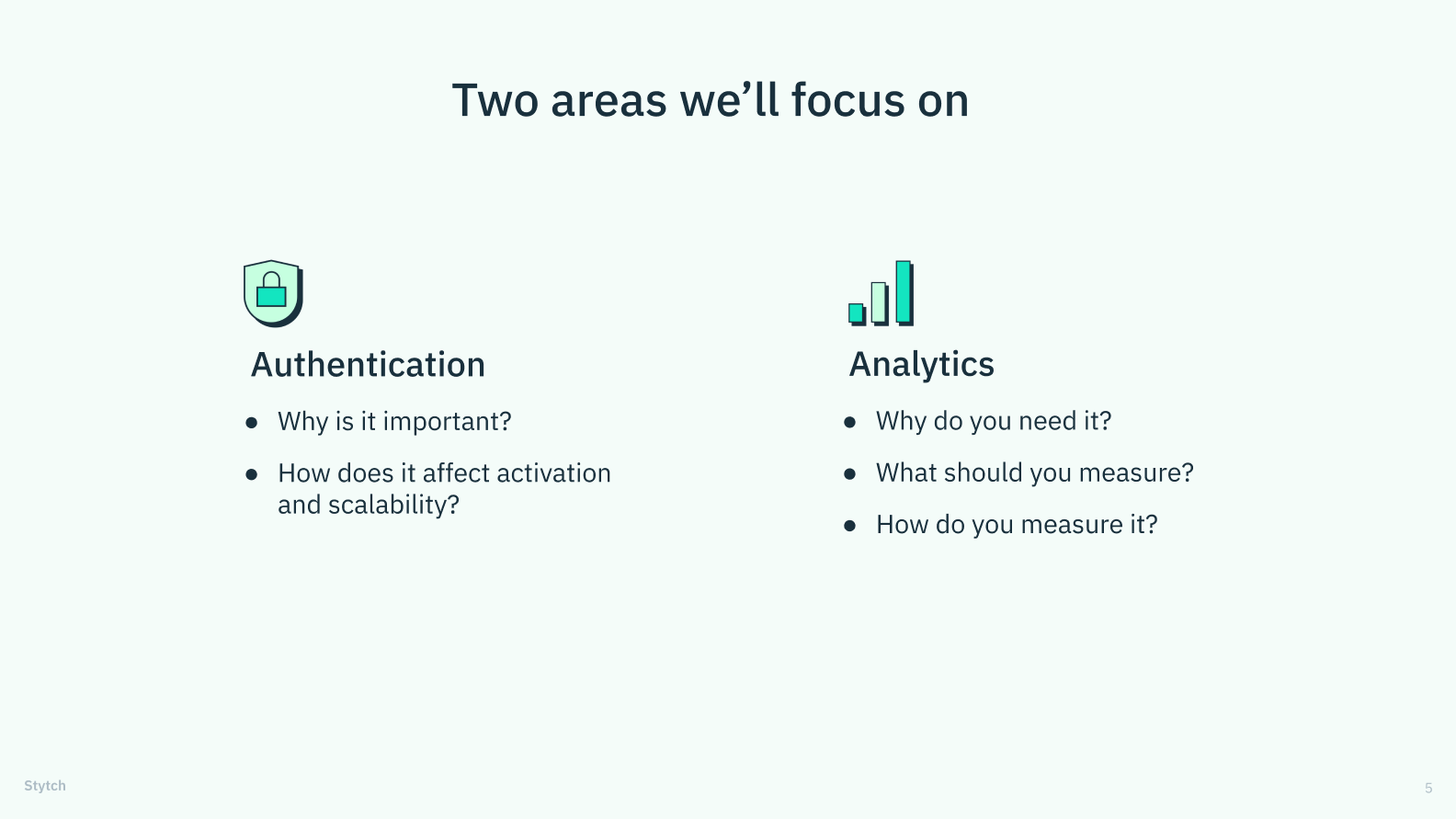
Auth is arguably the most critical investment you’ll make for your onboarding flow. It’s typically the first interaction a customer has with your app, and it has a direct impact on multiple touchpoints, from user experience and cybersecurity to product adoption.
While B2B auth methods are similar to B2C — they include passwords, 0Auth logins, email magic links, and so on — considerations differ from a data model perspective. That’s because B2C flows are focused on a single user, while B2B flows ultimately serve the organization that user belongs to. Organizations tend to have distinct security needs, often requiring advanced authentication and authorization settings. They might mandate the use of SSO or MFA, implement custom session duration limits, or have several levels of user access permissions. In short, while organizations care about the user experience, they also need to have complete control over user accounts to mitigate the risk of a data breach.


Reed had a few recommendations for building effective auth flows for the B2B market:
1. Meet organizations where they are on security.
When it comes to B2B auth, security is relative. It’s not only about the strength of your auth flows, but whether they fit the IT architecture and policies of the organizations you serve. You want to make sure you’re providing a range of factors for different verticals and levels of data sensitivity and that you have options in place if customers aren’t yet ready to go fully passwordless.
Chessly is a great example of an app doing this well on the B2C side. They offer a mix of auth factors, from secure passwords and Google OAuth to magic links and OTPs, basing their flows on customer demand to drive adoption.
2. Eliminate barriers to conversion and retention.
You want to get users to not only sign up for but return to your app. That means implementing low-friction auth flows and strategically managing sessions so users don’t hit dead ends.
For example, one common snag when B2B auth hasn’t been fully thought out is having a user try to join an organization, only to be told someone has already created an organization for that appdomain.com. They then have to identify the responsible team member and request access, resulting in needless friction and dropoffs — or they end up accidentally creating a duplicate account. Either way, it’s bad for business.
You want to get users to not only sign up for but return to your app. That means implementing low-friction auth flows and strategically managing sessions so users don’t hit dead ends. For example, one common snag when B2B auth hasn’t been fully thought out is having a user try to join an organization, only to be told someone has already created an organization for that appdomain.com. They then have to identify the responsible team member and request access, resulting in needless friction and dropoffs — or they end up accidentally creating a duplicate account. Either way, it’s bad for business.
Want multi-tenant auth without the headaches? Switch to Stytch.
Pricing that scales with you • No feature gating • All of the auth solutions you need plus fraud & risk
3. Build your auth flows to scale.
If you’re still young in B2B SaaS, you’re likely selling to smaller startups and SMBs. But over time, you’ll find you’re moving upmarket for larger deals. The reality is, as an organization grows, their auth needs change. Enterprises in particular tend to have more idiosyncratic identity policies, requiring complex solutions like MFA, SSO support, SAML and OIDC, approved domains, and just-in-time provisioning.
That means, even if you’re just starting out, It’s important to anticipate the need to scale your data model to accommodate these more complex tools, so they’ll just be a one-sprint effort when the time comes. As an example of the future customer headaches you can encounter in the B2B world, here’s a likely outcome when it comes to the various org-level differences 4 different customers might have in the future:

If you invest early, you can save a lot of future headaches, but also unlock a lot of future growth.
If you invest early, you can save a lot of future headaches, but also unlock a lot of future growth.
You’ll also want to decide when to start upcharging, and which services that will involve. For Stytch, our first upsell was allowing bigger customers (that is, those willing to pay more) to remove the “powered by Stytch” watermark at the bottom of their auth flow, so they could own their UX and UI from end to end.
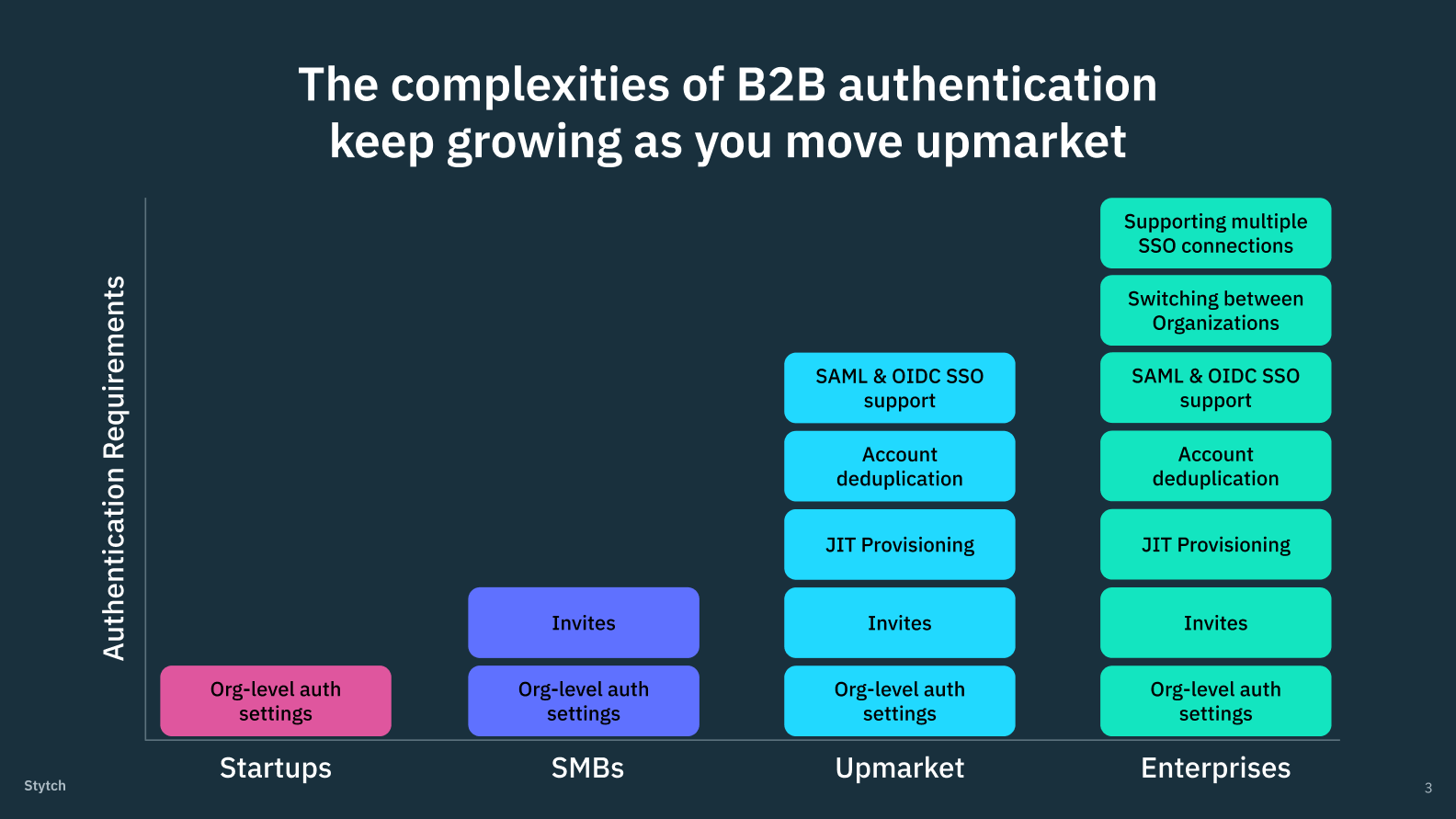
4. Auth can be a growth opportunity.
As you may remember from earlier Stytch Talks, auth isn’t just a box to check — it can be a differentiator.
Getting a B2B auth flow right can deliver real results. Consider Zapier, a workflow automation app that makes it easy for users to try the platform and invite other team members to join. Zapier made mild changes to their auth flow — like maximizing optionality and implementing Google OneTap (which recognizes active login sessions), ultimately increasing conversion rates by 20%.
The main takeaway? If you take time to think about your customer journey and reflect it in your auth flow, you can create seamless sign up and log in experiences that improve acquisition costs and lifetime value.
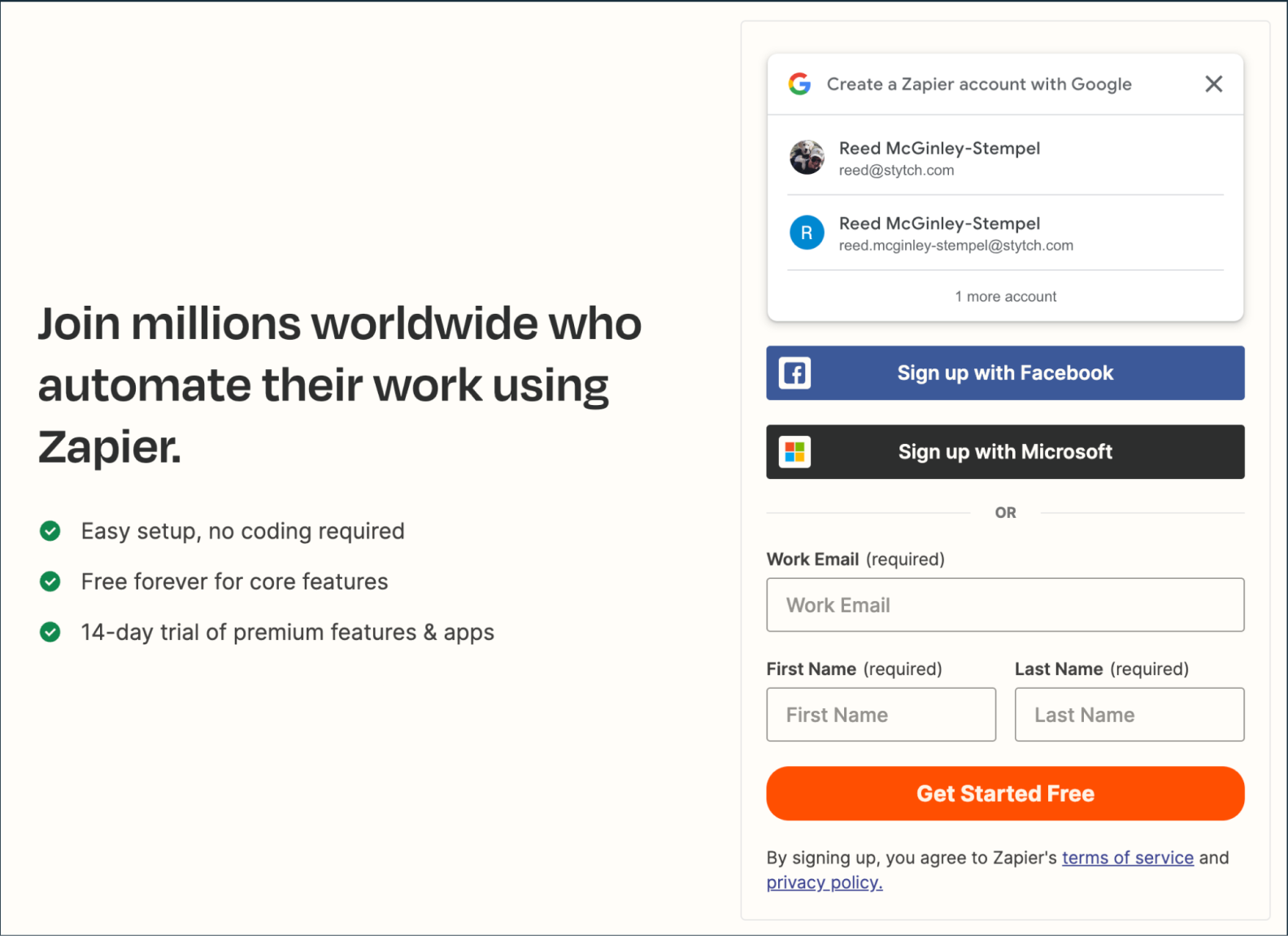
The role of analytics
Analytics allow you to measure the performance of your sign up flow once implemented and to use real data to identify and improve critical problem points in your onboarding process.
Whether you have no analytics program in place — or even if you have a mature analytics flow — Enzo had a few pointers to share around how tracking key metrics can help you move the needle.
1. Method matters.
When it comes to leveraging onboarding data, the first thing to think about is the method you will use — and there are three considerations to keep in mind:
- Activation, or the checkpoints users need to follow to ensure they not only land on but keep using your product. These will differ depending on your product category and vision, but there’s a simple data method you can use to find them. It involves looking into your best/busiest accounts, finding patterns in the actions they take, and using those patterns to create specific milestones. With an analytics tool like June, you can even determine when (and if) users are completing milestones, so you can organize customer support, marketing, and other initiatives to ensure success.
- At June, for instance, milestones include checking if and when users connect to a data source, invite teammates, and load at least 10 reports in their first week. The cherry on top is having users integrate June into their workflows, which allows them to receive value on autopilot and makes the product extra sticky in their day-to-day operations.
- Qualifying signups. In B2B SaaS, not every signup is equal. You’re going to have a lot of users who go through your onboarding flow, but your goal is to identify the relevant signups and learn from them. There are three important insights you can glean:
- Where users are coming from, whether you’re capturing the source of the signup through a UTM or posting a survey that asks users where they heard about your app. It’s important to figure out how GTM channels are performing, so you can allocate resources accordingly.
- User segmentation metrics, including job roles and functions, levels of product expertise, or main goal(s), so you can build ideal customer profiles (ICPs) and build your onboarding, sales, and customer success processes around real data
- Overall onboarding success, including common problem points where users are likely to drop off, so you can take actionable steps to improve them
- Moving beyond conversions. When users first visit your site, they’re an anonymous number. You don’t know much about them, other than they’ve agreed to your cookie policy. But then they start to navigate your product, complete your onboarding flow, and provide you with additional information.
- Analytics can help you reconcile the anonymous user data with their later, identified data by ensuring you have a cross-functional setup between your website and your app. The point is, if you look beyond conversion metrics and can connect earlier touchpoints to later behaviors, you can optimize your onboarding flows to match the actual journeys your users take.
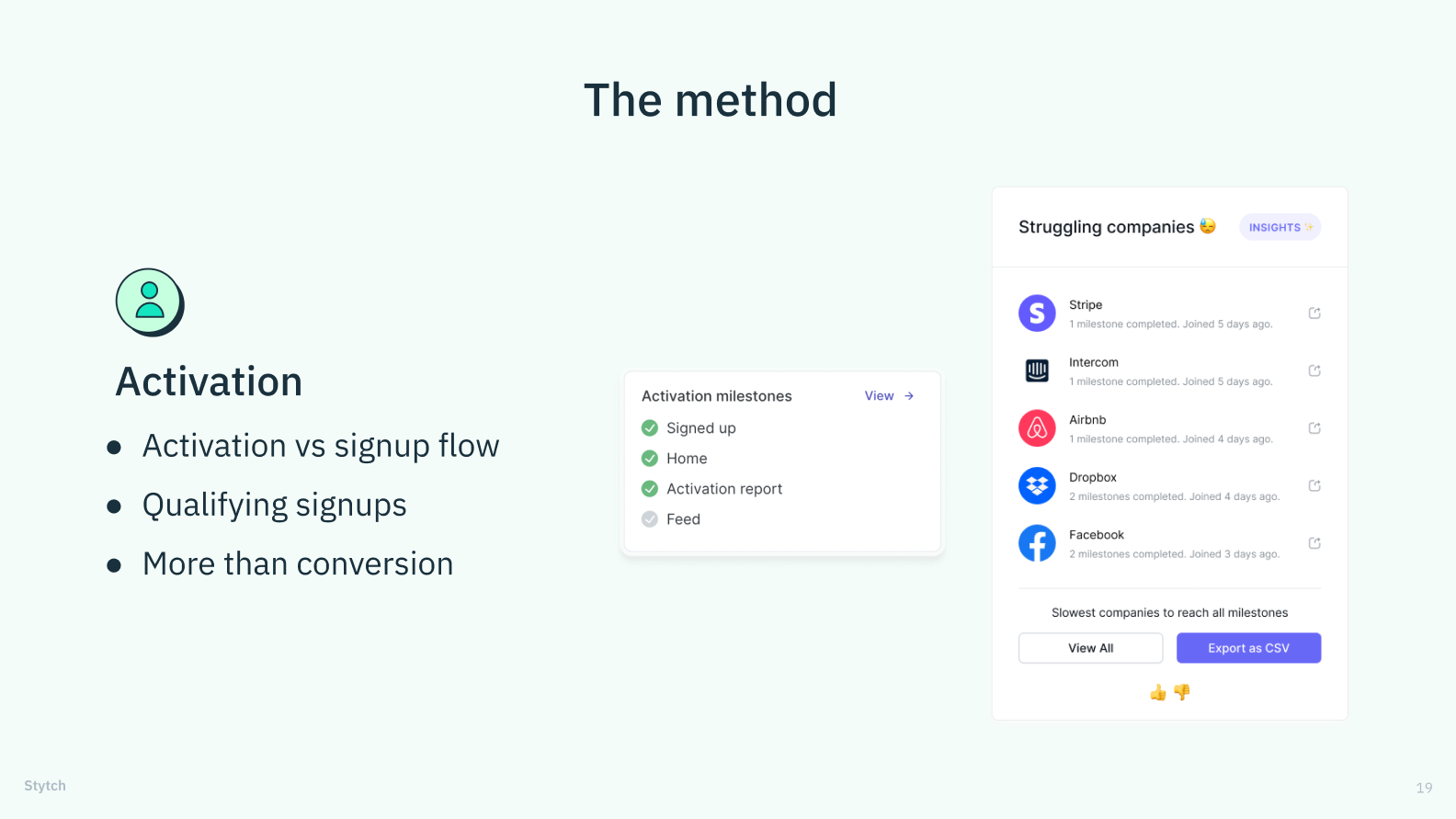
2. Onboarding flows aren’t set in stone.
It’s important to always be iterating on your onboarding experiences to improve their performance.
For example, at one point, June used a self-serve, forced-assist model, where users could sign up and at some point would be offered an account lease so they would take a call. They found that many users were taking calls, improving their activation, but many less-motivated users were instantly turned off. Over time, June shifted to branched onboarding, where tech-proficient users can self-serve, while others can invite someone for additional support.
We figure these things out over time by iterating on them. It’s important to understand that, with your onboarding flow, different auth methods, steps, and channels users take will lead to different outcomes.
We figure these things out over time by iterating on them. It’s important to understand that, with your onboarding flow, different auth methods, steps, and channels users take will lead to different outcomes.
3. Track user actions minimally and strategically.
You can visualize a user’s onboarding journey with a funnel view by tracking the linear steps they take — but track less, rather than more. If you track too many aspects of your product, you’ll quickly lose the crucial context around a user’s actions.
One suggestion is to track and compare only the first and last steps of your onboarding process. You can then assess how it’s performing by talking to other startup founders, product managers, and investors to gain a frame of reference. You can also use the user segmentation stats (outlined above) to strike an ideal balance for user stickiness. For example, you don’t want users signing up too quickly, not understanding your core value propositions, and ultimately dropping off.
4. Tracking analytics are simpler than they seem.
If you’re unfamiliar with tracking, there a few main concepts you can latch onto to get started:
- The identify call is how you capture personal data when users first sign up for your product and initiate your onboarding. From a technical standpoint, it’s a couple of lines of code that you insert in your sign up flow, including any data points you think are relevant — like email address or job title.
- The track event is the equivalent of a tag in Google Analytics. Basically, it’s a line of code that records if and when a user takes a specific action in your product — like clicking a certain button.
- Web to product analytics reconcile data on how and when users traveled from your site to your product. Most tracking tools have well-crafted documentation in place to help you through this.
Finally, it’s important to balance your desire for information against your users’ desire for low-friction flows. There’s a limit on how much you can ask at onboarding, and a good rule of thumb is to keep it to 2 screens and 2-3 questions — especially if you can capture this data in other ways. Also, make sure you’re providing a backdoor for users to skip questions if they wish, so they’re not just entering random answers (and skewing your data) to move forward.
The key takeaway here? First-party data can yield some surprising and fruitful results — and help you enhance your sign up and onboarding flows for greater conversions and engagement.
For example, June found that adding sharing options to the beginning of an onboarding flow, when users are still very excited about a new product, led to around a 15% uptick in user invites and an overall stickier organizational relationship.
Ultimately, data means knowledge, and knowledge means power over your UX, so you can build secure and frictionless flows that sustain and grow your business.
Want to learn more about optimizing your B2B SaaS sign up flow?
You can contact our panelists by emailing Reed at reed@stytch.com or reaching out to Enzo via LinkedIn. You can also watch a full recording of the webinar on YouTube — including a lively Q&A that addresses “aha moments” in onboarding, the build-versus-buy auth debate, and how to prioritize (and eventually monetize) the features your users want.
If you’re interested in learning other B2B SaaS best practices, check out our larger B2B Auth School series.
Authentication & Authorization
Fraud & Risk Prevention
© 2025 Stytch. All rights reserved.

